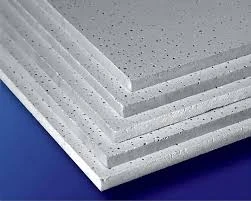10 月 . 21, 2024 18:15 Back to list
Comparing Gypsum Ceilings and PVC Ceilings Key Differences and Advantages
Differences Between Gypsum and PVC Ceilings
When it comes to choosing the right ceiling material for your home or commercial space, gypsum and PVC (polyvinyl chloride) ceilings are two popular options that often come up in discussions. Both materials have their own unique characteristics, advantages, and disadvantages. Understanding the differences between gypsum and PVC ceilings can help you make an informed decision that suits your specific needs.
Material Composition
Gypsum ceilings are made from gypsum board, which consists of a core of gypsum, a mineral composed of calcium sulfate dihydrate, sandwiched between two sheets of paper or fiberglass. This composition gives gypsum ceilings their fire-resistant properties and ability to withstand various environmental conditions.
On the other hand, PVC ceilings are made from polyvinyl chloride, a type of plastic. PVC is known for its durability and resistance to moisture and chemicals, making it an ideal choice for areas prone to humidity, such as bathrooms and kitchens.
Aesthetic Appeal
Aesthetically, gypsum ceilings offer a more traditional and elegant look. They can be easily painted or finished to match the décor of your space. Additionally, gypsum can be molded into various shapes, allowing for architectural features such as cove ceilings, moldings, or decorative finishes.
PVC ceilings, while also available in a range of colors and designs, often have a more modern and minimalist appearance. They come in various textures and can mimic the look of wood, tiles, or even metal. However, some might argue that PVC lacks the classic charm that gypsum can provide.
Installation Process
The installation process for gypsum ceilings can be more labor-intensive and complex. Gypsum boards are heavy and require proper support structures. Installation usually involves framing the ceiling and then attaching the boards, followed by taping and finishing the joints, which can be time-consuming and requires skilled labor.
Conversely, PVC ceilings are relatively easy to install. They are lightweight and can be directly mounted onto an existing ceiling with minimal framing. This ease of installation can be a significant advantage, especially for DIY enthusiasts or those looking to save on labor costs.
difference between gypsum and pvc ceiling

Cost
Cost is another critical factor to consider. Gypsum ceilings tend to be more economical in regions where materials and labor are affordable. However, the overall cost may rise due to the additional labor required for installation and finishing.
PVC ceilings, while generally more expensive per square foot, can save money in the long run due to their ease of installation and lower maintenance costs. They are also less prone to issues such as mold and decay, which can arise with gypsum in high-moisture environments.
Durability and Maintenance
In terms of durability, PVC ceilings have the upper hand. They are highly resistant to water, insects, and mold, which makes them an excellent choice for humid areas. A simple wipe with a damp cloth is usually sufficient to keep them clean.
Gypsum ceilings, while they can offer excellent insulation properties, are susceptible to water damage. Moisture can cause them to sag or develop mold over time, requiring more maintenance and potentially leading to costly repairs.
Sound Insulation
Both gypsum and PVC ceilings provide sound insulation, but gypsum ceilings are often favored for their superior acoustic properties. Gypsum board can effectively reduce sound transmission, making it beneficial for offices, schools, and multi-family dwellings. PVC's acoustic performance, while acceptable, may not match that of gypsum in high-noise environments.
Conclusion
In conclusion, both gypsum and PVC ceilings offer unique advantages and disadvantages. Gypsum ceilings provide a classic aesthetic, impressive durability, and superior sound insulation but come with more complex installation and maintenance needs. On the other hand, PVC ceilings are lightweight, moisture-resistant, and easy to install but may lack the traditional charm and acoustic performance of gypsum. Ultimately, the choice between gypsum and PVC ceilings will depend on your specific requirements, budget, and the characteristics of the space you are working with.
-
Revolutionizing Interior Design with Ceilings t grid Suspended SystemNewsOct.29,2024
-
Revolutionizing Ceiling Design with ceiling access panel with Gypsum Tile WaterproofNewsOct.29,2024
-
Revolutionizing Interior Design with PVC Gypsum Ceiling: A Comprehensive GuideNewsOct.29,2024
-
Elevating Interior Design with High quality Mineral Fiber Ceiling TilesNewsOct.29,2024
-
Revolutionizing Interior Design with PVC Gypsum Ceiling: A Comprehensive GuideNewsOct.29,2024
-
Elevating Interior Design with High-Quality Mineral Fiber Ceiling Tiles: A Comprehensive GuideNewsOct.29,2024







